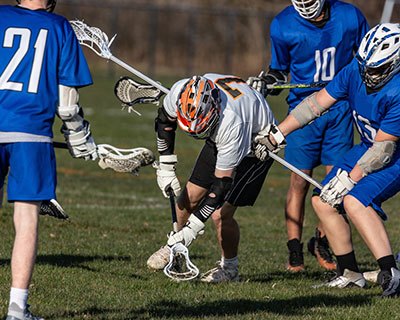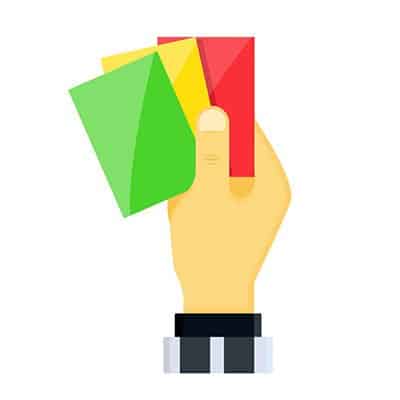Understanding the ins and outs of lacrosse penalties is essential to mastering the game. One penalty, in particular, is a vital part of defending your team – that's the defenseless player penalty.
This comprehensive guide will take you through all the details surrounding this penalty and how it affects both teams.
From understanding when fouls occur to learning about different offenses, you'll learn everything you need to know to play a clean game confidently.
More...
Take Away Key Points:
Lacrosse defenseless player penalty explained
If you don't know much about the rule violation and defenseless player penalty, refer to the guide below for a better understanding.
1. What is a defenseless player penalty?
A defenseless player penalty is a type of personal foul in lacrosse, a foul caused by malicious intent. The penalty occurs when one player performs an illegal body check on the opposing player in a vulnerable position.
Such examples include situations when a player is facing another direction or is in the air, unable to protect themselves.
2. When is body checking a player dangerous?

In NCAA men's lacrosse, high school level, and youth lacrosse, unnecessary roughness during hits on a defenseless player is considered both illegal and dangerous. For this reason, the officials invented the defenseless player penalty to protect all players from severe injuries and keep player safety optimal.
The penalty was created to discourage the players from malicious checks and keep the game at the same and higher level. A player's illegal stick checking or body checking can result in a one to three-minute penalty sentence in the penalty box or even ejection from the game in extreme cases of unsportsmanlike conduct.
The penalty occurs when an offending player uses his stick or body to check the defenseless player. Thus, the player receiving a hit is unable to defend and cannot protect themselves fully from unnecessary roughness.
The referee will make the call on the lacrosse field, and they must use their judgment to determine whether the offensive player has violated the rules. Because of the dangerous behavior of hitting a defenseless player, repeat offenders will automatically be expelled from further play.
However, if the referee determines the offender was violent enough during the first contact, the officials can expel the illegal player instantly. There is zero tolerance for this kind of play in high school and youth lacrosse, as young players can develop hazardous habits.
3. When will a lacrosse player go to the penalty box?
The penalty for hitting a defenseless player will change due to the judgment of the referee and the lacrosse league level.
For instance, an illegal body check in high school and youth lacrosse will cause a more severe penalty as it's a personal foul. Thus, violating lacrosse rules will result in the ejection of the violating player.
In high school lacrosse, the violation of lacrosse rules leads to serving a time penalty in the box. The time-serving penalty is between one and three minutes.
The same rule applies to the collegiate level, and professional lacrosse as the NCAA and NFHS rule list is also non-tolerant of this type of misconduct. Thus, the referee will stop play, and instead of the three-minute non-releasable penalty, they will eject the aggressive players immediately.
4. Can a lacrosse loose ball lead to the defenseless player penalty?
In lacrosse, any contact from a player against another player who is deemed to be in a defenseless position by the umpire is considered a defenseless player penalty.
This includes contact to the head or neck area. For example, it often happens when a player tries to play a loose ball, and there is contact between them and an opponent with their head down, leaving them unprotected and vulnerable.
Hence, it's important for players at all levels of the game to be aware of what consists of a defenseless player since it will result in either the player being disqualified or risk other players sustaining injuries due to dangerous play.
5. What will a referee do to call out a defenseless player penalty?
When a referee notices an illegal hit on a defenseless player, he will instantly throw a flag to signal a penalty. Then, the official will raise their hand to their hat in a salute-like manner.
The official must evaluate and determine the severity of the offender's actions and see whether there is violence. Then, they can assess a one to three-minute non-releasable penalty for the offender at the official's discretion or expel the player if he severely violated the lacrosse rules.
6. What are the examples of the penalty?
Here are the most common examples of defenseless player penalties:
- A player hitting his opponent while trying to recover the ground ball.
- A player has jumped in the air, and the defender hinders their landing ability. A defender can also take their legs out from under them.
- A player has their back turned to the opponent, and the opponent hits them aggressively in the back while they are not looking.
- A player on the offense passes the ball to his team member, takes a shot at the goal, and completes the action. However, the defender makes contact after the ball has left the attacker's stick.
- Illegal body check of a lacrosse player from his blind side hit.
- Illegal body checking a player whose head is turned away to receive a pass, even if the lacrosse player turns toward the contact immediately before the body check.
Similar penalties to defenseless player penalties

The defenseless player penalty in lacrosse is a violation that penalizes any dangerous contact with an unsuspecting or defenseless player.
In addition to defenseless player penalties, referees may also call: unsportsmanlike conduct, illegal body-check, illegal cross-check, targeting, and unnecessary roughness.
Unsportsmanlike
Unsportsmanlike conduct is when a player swears, argues with the referee, or engages in any other behavior that interferes with gameplay.
Illegal body-check
Illegal body-check refers to checking a player above the shoulders, below the waist, and from behind - the blind side hit.
In addition, no take-out checks are allowed to prevent severe injuries and protect the players.
Illegal cross-check
Illegal cross-check refers to a player spreading his hands apart on his stick and using his shaft to push the opponent rather than using his hands.
Targeting
Targeting includes misconduct when a player deliberately aims at the opponent's head or neck and hits the area aggressively.
Unnecessary roughness
Unnecessary roughness is a penalty taking place when a player conducts a check determined as violent, deliberate, and avoidable by the officials.
Summary
The lacrosse defenseless player penalty is a crucial rule that protects players from violence and keeps the game optimal.
To keep the game safe and fair, all players need to know this rule and understand when it applies.
By understanding and following this rule, players can help ensure that all enjoy the game of lacrosse.
